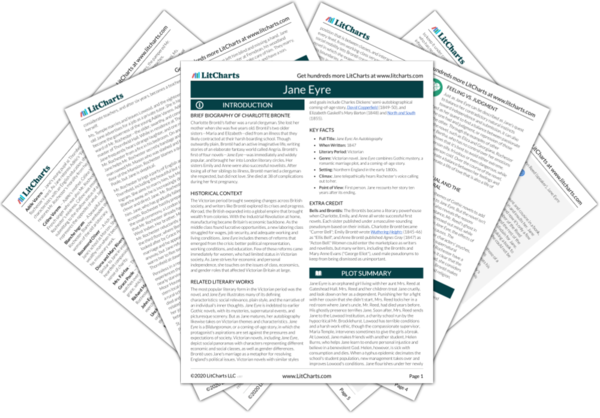Love, Family, and Independence
As an orphan at Gateshead, Jane is oppressed and dependent. For Jane to discover herself, she must break out of these restrictive conditions and find love and independence. Jane must have the freedom to think and feel, and she seeks out other independent-minded people as the loving family she craves. Jane, Helen Burns, and Ms. Temple enjoy a deep mutual respect, and form emotional bonds that anticipate the actual family Jane finds in Mary…
read analysis of Love, Family, and IndependenceGender Roles
In 19th-century England, gender roles strongly influenced people's behavior and identities, and women endured condescending attitudes about a woman's place, intelligence, and voice. Jane has an uphill battle to become independent and recognized for her personal qualities. She faces off with a series of men who do not respect women as their equals. Mr. Brocklehurst, Rochester, and St. John all attempt to command or master women. Brontë uses marriage in the novel to…
read analysis of Gender Roles
Religion
Religion and spirituality are key factors in how characters develop in the novel. Jane matures partly because she learns to follow Christian lessons and resist temptation. Helen Burns introduces Jane to the New Testament, which becomes a moral guidepost for Jane throughout her life. As Jane develops her relationship with God, Mr. Rochester must also reform his pride, learn to pray, and become humble. Brontë depicts different forms of religion: Helen trusts in salvation; Eliza…
read analysis of ReligionFeeling vs. Judgment
Just as Jane Eyre can be described as Jane's quest to balance her contradictory natural instincts toward independence and submission, it can also be described as her quest to find a balance between passionate feeling on the one had and judgment, or repression of those feelings, on the other. Through the examples of other characters in the novel, such as Eliza and Georgiana, Rochester and St. John—or Bertha, who has no control over her emotions…
read analysis of Feeling vs. JudgmentThe Spiritual and the Supernatural
Brontë uses many themes of Gothic novels to add drama and suspense to Jane Eyre. But the novel isn't just a ghost story because Brontë also reveals the reasons behind supernatural events. For instance, Mr. Reed's ghost in the red-room is a figment of Jane's stressed-out mind, while Bertha is the "demon" in Thornfield. In Jane Eyre, the effects of the supernatural matter more than the causes. The supernatural allows Brontë to explore…
read analysis of The Spiritual and the Supernatural







Social Class and Social Rules
Life in 19th-century Britain was governed by social class, and people typically stayed in the class into which they were born. Both as an orphan at Gateshead and as a governess at Thornfield, Jane holds a position that is between classes, and interacts with people of every level, from working-class servants to aristocrats. Jane's social mobility lets Brontë create a vast social landscape in her novel in which she examines the sources and consequences of…
read analysis of Social Class and Social Rules